Are you looking to buy beef in bulk but not sure how much is a quarter cow? This is a common question among those buying meat directly from the source. The cost of a quarter cow can vary depending on the animal’s weight, breed, and location. Consumers typically expect to pay between $1,200 to $1,350 for a quarter cow, which can provide substantial meat for a family or group of individuals. In this article, we will explore the factors that affect the price of a quarter cow and help you determine if buying in bulk is the right choice for you.
What Factors Affect The Cost Of Quarter Cow?
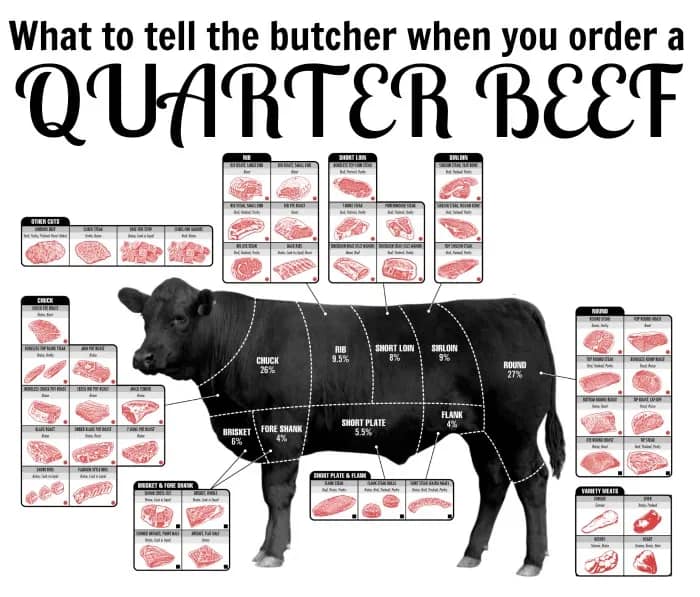
When buying a quarter cow, several factors can affect the price. From the meat quality to the feed given to the cow, these factors all play a role in determining how much you’ll be paying for your quarter cow.
First, the quality of the meat will greatly influence the cost of the quarter cow. If the cow is grass-fed, the meat will be of higher quality and more expensive. On the other hand, feedlot cows will cost less due to the lower quality of their meat. If you’re looking for the best quality beef, grass-fed is the way.
Second, the cow’s age can also play a role in the cost of the quarter cow. Generally, older cows will be more expensive due to their higher-quality meat. Younger cows may be less expensive, but the meat quality may not be as high.
Third, the feed given to the cow can also affect the price of the quarter cow. Cows that are given feed composed of grains, legumes, and hay will be more expensive than those that are only given grain feed. This is because the additional ingredients in the feed will add nutrients and flavor to the meat.
Fourth, the location of where the cow was raised can also affect the cost of the quarter cow. Cows raised in rural areas will be less expensive due to the lower cost of living and access to natural resources. On the other hand, cows raised in urban areas may be more expensive due to the higher cost of living.
Finally, the butcher you purchase the quarter cow from may also affect the price. Different butchers may have different prices based on the supply, demand, and quality of their meat. Shopping around is essential to ensure you’re getting the best deal.
How Much Is A Quarter Cow?
A quarter cow generally ranges between $1,200 to $1,350, depending on the animal’s size. This beef will yield around 100-150 pounds, perfect for a small family or couple. Unlike buying beef at the grocery store, there are no extra butcher charges or hanging weights to worry about. It is a straightforward pricing method.
If someone is interested in purchasing a quarter cow, it is recommended to find a reputable farm or seller and ask questions regarding the weight and cost involved in such a purchase. Overall, a quarter cow may be a great choice for those who enjoy having meat readily available and are looking for a cost-effective way to purchase it.
What Are The Benefits Of Buying A Quarter Cow Instead Of Individual Cuts Of Beef?
1. Incredible Value for Money
When you buy a quarter cow, you’re essentially buying in bulk, which translates into significant savings. On average, purchasing in bulk can save you around 15% compared to buying individual cuts. By getting a variety of cuts from your quarter cow, including steaks, roasts, ground beef, and more, you’ll be paying a single price per pound, making it a cost-effective investment for meat lovers.
2. Stock Up for the Long Haul
One of the greatest advantages of purchasing a quarter cow is the ability to stock up on a substantial amount of meat. For example, a quarter cow can provide approximately 100 pounds of beef, which is enough to keep a small family well-stocked for an entire year. By investing in a quarter cow, you’ll have a freezer full of grass-fed beef, ensuring that you never run out or have to regularly visit the grocery store.
3. Customized Cuts to Suit Your Tastes
When you buy a quarter cow, you have the opportunity to customize the cuts according to your preferences. Whether you prefer thicker steaks, specific roasts, or an abundance of ground beef, working with a trusted butcher allows you to tailor the cuts to your liking. This level of customization ensures that you get the most out of every pound of beef and guarantees a dining experience that suits your palate perfectly.
4. Support Local Farmers and Know Your Beef’s Origin
By purchasing a quarter cow, you benefit yourself and support local farmers. Buying locally ensures that your beef is raised under the highest standards, with animals given the care, attention, and natural diets they deserve. Additionally, knowing where your beef comes from allows you to align your values with your consumption choices. You can be confident that you’re nourishing yourself with ethically sourced, quality beef each time you enjoy a meal.
5. Explore New Culinary Adventures
Buying a quarter cow introduces you to exciting culinary possibilities. With a wide range of cuts at your disposal, you can venture beyond the usual steaks and explore new recipes. This culinary adventure may lead you to discover new family favorites you wouldn’t have otherwise encountered. Embracing creativity in the kitchen enhances your overall dining experience and adds variety to your meals.
How Much Meat Can I Expect To Receive From A Quarter Cow?
If you’re considering buying a quarter cow or beef, you might be wondering how much meat you can expect to receive. According to factual data, a quarter cow typically has 100 to 150 pounds of actual take-home meat. That meat mixes ground meat, ribs, steak, and other cuts.
The meat you receive depends on the animal’s size and processing. So, you can expect to receive about 4-5 different cuts of meat, such as ground beef, NY Strip Steak, Top Sirloin Steak, Rump Roast, Sirloin Tip Roast, and Flat Iron Steak. Generally, most cattle have an average dressing percentage of 63 percent, meaning you can expect to receive about 63% of the cow’s live weight as take-home meat.
Are There Any Additional Fees Or Charges When Purchasing A Quarter Cow?
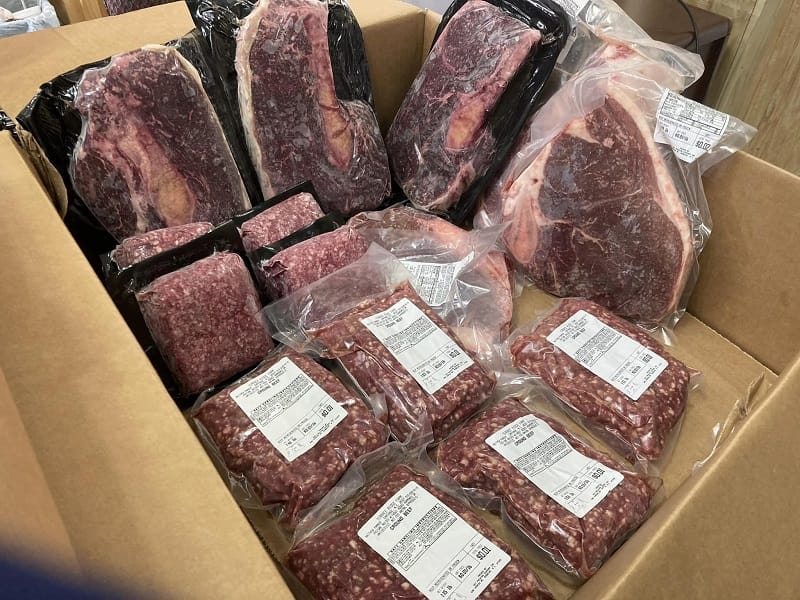
When buying a quarter cow, you must consider all the possible costs. In addition to the purchase price, you’ll need to factor in things like feed, bedding, and vet bills. You may also need to pay for things like vaccinations and deworming, so research before purchasing.
Another cost to consider is the cost of processing the cow. Processing a cow involves killing the animal, butchering it, and wrapping it up for sale. Depending on where you live, you may need to pay a local processor or a slaughterhouse to process the meat.
Finally, you’ll also need to consider the cost of transporting the cow. Depending on your location, you may need to rent a truck or trailer to move the cow to the processor or slaughterhouse.
As you can see, many costs are associated with purchasing a quarter cow. While it’s important to do your research and factor in all the possible costs, it’s also important to remember that buying a quarter cow is a great way to get high-quality meat at an affordable price. With proper care and maintenance, a quarter cow can provide you with years of delicious meals.
Read more:
- What Part Of The Cow Is Ribeye
- What Part Of The Cow Is Brisket
- What Part Of The Cow Is Filet Mignon
- How Many Ribeyes In A Cow
- Where Is The Tri Tip On A Cow
- How Many Briskets Per Cow
- How Much Is A Whole Cow
- How Much Does A Half Cow Cost
What Types Of Cuts Are Included In A Quarter Cow?
But what types of cuts are included in a quarter cow? Well, that can vary depending on the type of cow and the butcher, but generally, you can expect to find the following cuts in a quarter cow:
- Ribeye Steaks: These are some of the most sought-after steaks in the world, and for a good reason. Ribeye steaks are packed with flavor and offer a rich, juicy texture.
- Chuck Roasts: Chuck roasts are a great choice for slow cooking. This cut of beef is packed with flavor and can be used in various dishes, such as soups and stews.
- Brisket: This cut of beef is perfect for making slow-cooked barbecue brisket. It’s incredibly tender and packed with flavor.
- Sirloin Steak: Sirloin steaks are a popular beef cut and great for grilling. They offer a leaner, more tender texture than some of the other cuts of beef.
- Short Ribs: These cuts of beef are great for braising and slow cooking. They are incredibly flavorful and tender.
- Rump Roast: Rump roasts are great for slow cooking as well. They are also very flavorful and tend to be a bit more tender than other cuts of beef.
Tips for Buying A Quarter of a Cow
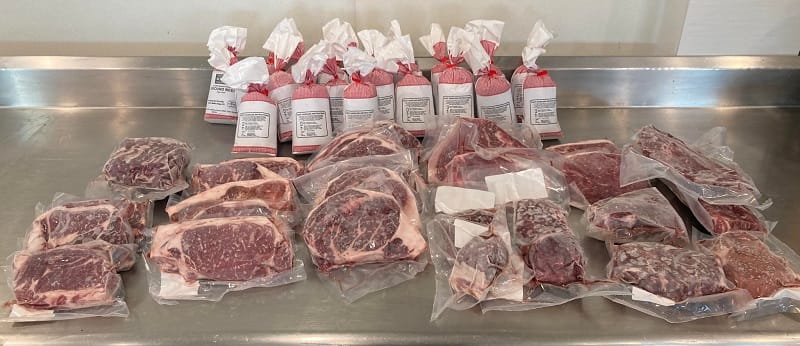
Before you make your purchase, there are a few things to consider. Here are our top tips for buying a quarter of a cow:
- Find a reputable supplier. When buying a quarter of a cow, you want to ensure you’re getting the best quality meat possible. So, finding a trusted and reputable supplier who can provide you with the freshest, ethically-sourced meats is important. Do some research and read reviews to ensure that you’re getting quality meat from the source.
- Choose the right cut. Depending on what you’re planning on cooking, you’ll want to choose the right cut of meat for your needs. A quarter of a cow can provide various cuts, including steak, ground beef, pork chops, roasts, and more. Think about your cooking and choose the right cut for the job.
- Know what to expect. Before buying a quarter of a cow, ensure you understand how much meat you’ll be getting. Depending on the size of the cow, you can expect anywhere from 40-60 pounds of meat or more. This is enough to feed a family of four for several months.
- Consider the cost. Buying a quarter of a cow can be expensive, but it’s worth it if you’re looking for quality, ethically-sourced beef, pork, and other meats. Shop around to compare prices and ensure you get the best deal.
- Know the storage requirements. You’ll need a place to store your quarter of a cow—either in your freezer or deep freezer. Ensure you have the correct temperature and storage requirements to keep your meat fresh.
Hanging Weight vs Live Weight
Hanging weight refers to the weight of the carcass after it’s been slaughtered and not yet processed. This weight is usually measured before the animal is skinned and eviscerated, so it does not include any by-products such as skin, bones, or fat. It’s important to note that hanging weight only accounts for about 75-80% of the total live weight, depending on the type of animal.
On the other hand, live weight is the animal’s total weight after processing. This includes the skin, bones, fat, and other by-products not accounted for in hanging weight. Since live weight is slightly heavier than hanging weight, you’ll also pay a premium.
When it comes to price, hanging weight is generally significantly cheaper than live weight. This is because the butcher has to use more time and energy to process the carcass, which drives up the cost. If you’re looking for the most economical option, hanging weight is the way to go.
On the other hand, if you’re looking for the highest quality, a live weight is usually the better choice. The extra money you’ll spend on live weight will often be well worth it, as you’ll get a larger portion and higher quality meat.
Hanging and live weight have their benefits, and it’s essential to consider both when purchasing. With a bit of research, you should be able to find the right option for your needs and budget.
Bone-In Versus Boneless
One of the major considerations is whether to buy bone-in or boneless cuts of beef. Both have advantages and disadvantages, and choice can be an important factor in determining the price of a purchase.
Bone-in cuts of beef are generally cheaper than boneless cuts. This is because the bones add extra weight to the cut of beef, so a pound of bone-in beef will cost more than a pound of boneless beef. This added weight also translates into more flavor, as the bones contain marrow, adding flavor to the beef. Additionally, bone-in cuts can be cooked slowly to bring out even more flavor.
On the other hand, boneless cuts of beef are typically more expensive than bone-in cuts. This is because the butcher has to trim the fat and remove the bone before packaging the beef, which adds to the cost. Boneless cuts are generally leaner and can be cooked quickly, making them ideal for weeknight meals. However, they may lack flavor compared to bone-in cuts.
In terms of cost, it comes down to personal preference and budget. Bone-in cuts of beef typically cost less, but they require more time and effort to cook. Boneless cuts are generally more expensive but usually leaner and can be cooked quickly.
What Does a Quarter of a Cow Look Like?
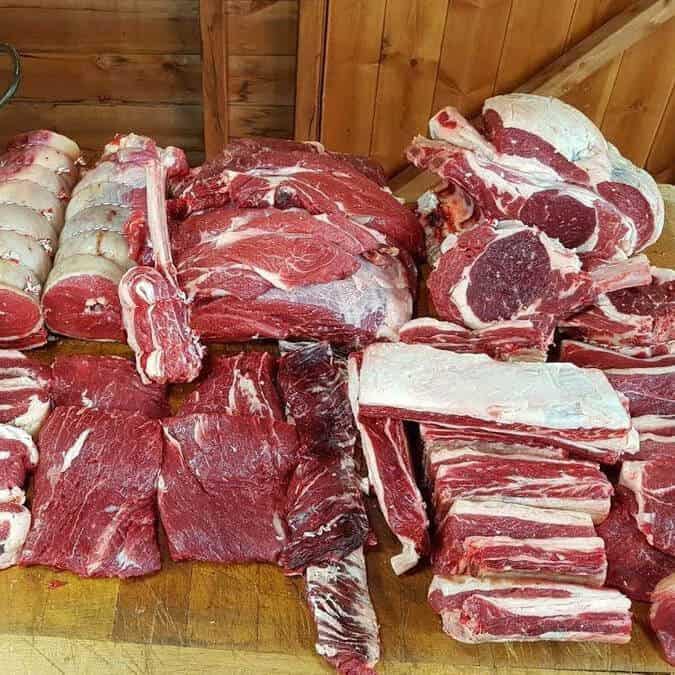
What does a quarter of a cow look like? Well, it’s pretty straightforward. A quarter of a cow is a package of beef broken down into four equal pieces. Each piece is about 1/4 of the cow’s total weight, with each piece containing a variety of cuts.
For example, the chuck section of a quarter of a cow will typically include chuck roast, chuck steak, and blade steak. The brisket section will include brisket, boneless short ribs, and flat iron steak. The flank section will include flank steak and London broil. The sirloin section will include sirloin steak, tip, tri-tip, and top sirloin. The rib section will include ribeye steak and ribeye roast. And the round section will include round steak and a top round roast.
When all of these cuts are put together, a quarter of a cow can weigh anywhere from 40 to 60 pounds, depending on the size of the cow. A quarter of a cow usually comes in a vacuum-sealed bag; if appropriately stored in a freezer, it can last up to a year.
Know the Difference Between Cut Weight and Hanging Weight
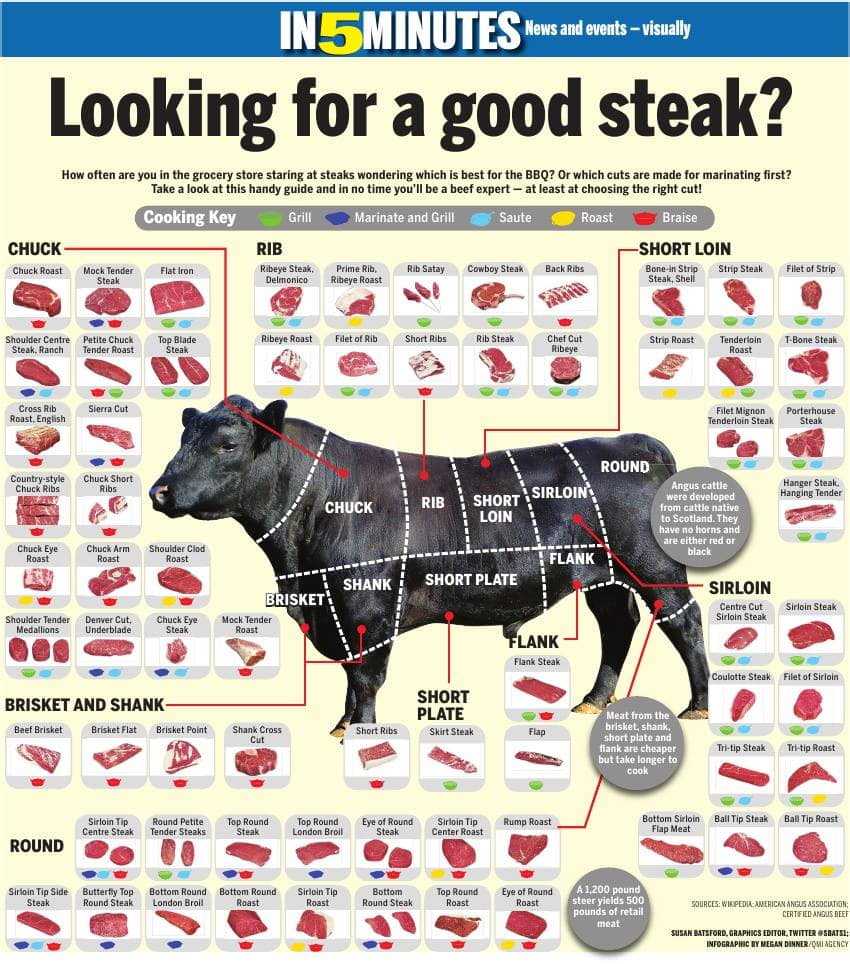
Cut weight is the weight of the carcass after it has been cut while hanging weight is the weight of the carcass before it has been cut. Though these two weights are not the same, they are both important measurements when dealing with cattle and their meat.
Cut weight is the weight of the carcass after it has been cut into prime cuts such as steaks, roasts, and hamburgers. This weight is determined by taking the weight of the carcass before it is cut and subtracting the weight of the bone, fat, and hide. The cut weight of a cow is usually around 65-70% of the original live weight. This is the weight used to determine the price per pound of various cuts of beef.
Hanging weight, on the other hand, is the weight of the carcass before it is cut. This weight includes the cow’s bone, fat, hide, and head. This weight is essential for determining the yield of beef from the carcass. The hanging weight will usually be around 60% of the original live weight of the cow.
Knowing the difference between cutting and hanging weights is important for anyone interested in the beef industry or raising cattle. Cut weight is the weight used to determine the price per pound of various cuts of beef while hanging weight is the weight used to determine the yield of beef from the carcass. Awareness of these two weights can help you make more informed decisions when dealing with cattle and their meat.
How Much Freezer Space Do You Need for a Quarter of a Cow?
Are you thinking of purchasing a quarter of a cow for your family but not sure how much freezer space you’ll need? You’ll want to have roughly four cubic feet of freezer space available for a quarter share, which typically yields around 85 pounds of meat. However, it’s essential to remember that this can vary based on the specific cut and packaging of the meat.
As a general rule of thumb, aim to have at least one cubic foot of freezer space for each 35-40 pounds of cut and wrapped meat. With this in mind, you can confidently purchase your quarter share, knowing you have the proper freezer space to store your delicious cuts of beef.
How Often Do You Need To Eat Beef In Order To Finish A Quarter Cow Within A Certain Timeframe?
When purchasing a quarter of beef, you can expect it to yield approximately 100-150 pounds of cut-wrapped and frozen meat. However, it is important to note that each beef will vary in size so these weights may vary slightly.
To estimate how often you need to eat beef to finish a quarter cow, let’s assume you have a 130-pound quarter. If you plan to finish it within a month, you would need to consume about 4.3 pounds of beef per day, which could be quite a lot for one person. Therefore, planning for a longer timeframe, such as three months, might be more realistic.
In that case, you would need to consume approximately 1.4 pounds of beef per day to finish the quarter cow within three months. This would still be a generous amount of beef, so it’s important to consider your personal dietary preferences and needs.
Remember, the actual amount of take-home meat will be less than the hanging weight due to moisture loss and waste during the butchering process. So, keep this in mind when planning your consumption.
Are There Any Special Requirements For Storing And Handling Beef From A Quarter Cow Purchase?
When it comes to beef, proper storage and handling are essential for preserving flavor and texture. For those who purchase beef from a quarter cow, there are specific requirements for storing and handling the meat to ensure its safety and quality.
First, it is important to know the source of the beef. Ensure it is from a reliable retailer, such as a local butcher or grocery store, and that it is USDA certified. Once the beef is purchased, it should be refrigerated immediately to maintain its freshness.
When storing beef from a quarter cow, wrap it tightly in plastic wrap or butcher paper. This helps prevent the beef from drying out and becoming tough. Keep the beef in the refrigerator and consume it within three to four days of purchase. If freezing, the beef should be tightly wrapped, placed in a freezer bag, and consumed within three to four months.
When it comes time to cook the beef, ensure it is thoroughly cooked and that the internal temperature reaches at least 145 degrees Fahrenheit (63 degrees Celsius). This will help to reduce the risk of foodborne illnesses.
Finally, it is important to follow kitchen safety guidelines when handling beef. Always use separate cutting boards for raw and cooked meats. Thoroughly wash hands, utensils, and cutting boards with warm, soapy water before and after handling the raw beef.
What Is The Shelf Life Of Cow Meat?
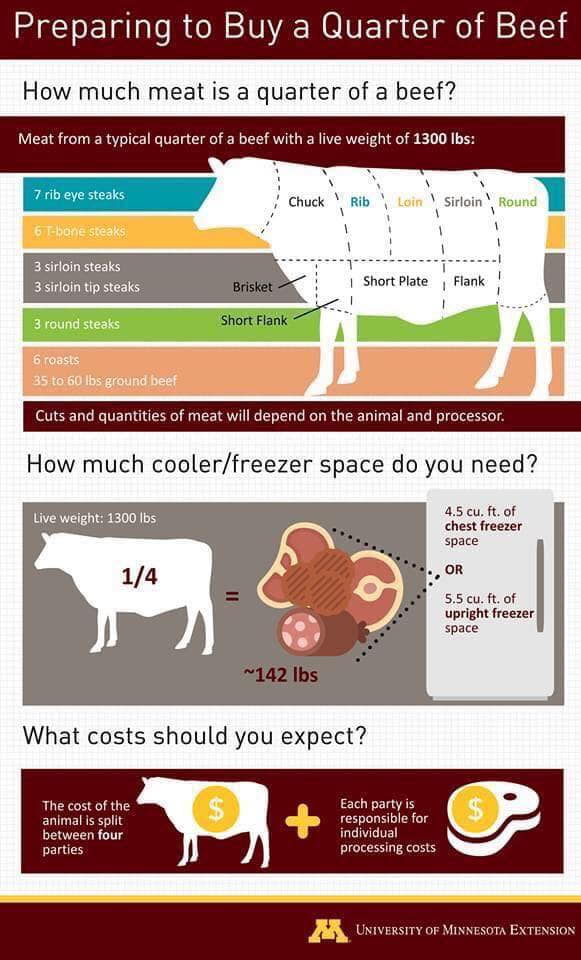
To begin with, it’s important to know that the shelf life of cow meat is based on the cut of meat. Different cuts of cow meat have different shelf lives, so you should always check the meat’s label to see how long it can last. Generally speaking, beef roasts and steaks have a shelf life of up to 5 days in the refrigerator, while ground beef and stew beef can last up to 3 days. If you plan to freeze your cow meat, it can last up to 3 months.
Let’s take a closer look at some of the most popular types of cow meat and their shelf lives:
- Ground beef – Ground beef has a relatively short shelf life. It can last up to two days when stored in the refrigerator. However, if it’s frozen, it can last for up to six months.
- Steaks – Steaks can last for up to four days in the refrigerator, but if frozen, they can last up to 12 months.
- Roasts can last up to four days in the refrigerator, but if frozen, they can last up to a year.
- Liver – The liver can last up to three days in the refrigerator, but if frozen, it can last up to six months.
- Tongue – The tongue can last up to three days in the refrigerator, but if frozen, it can last up to a year.
The quality of the cow meat you buy will also affect its shelf life. High-quality meat will last longer than low-quality meat. For example, suppose you buy organic grass-fed beef. In that case, it will likely last longer than conventional beef because organic cows are usually raised in healthier conditions and fed a more nutritious diet.
The storage conditions of cow meat will also impact its shelf life. If you store it in the refrigerator, you should ensure it is in an airtight container or wrapped tightly in plastic to keep it from drying out. It’s also important to keep the refrigerator’s temperature consistent – the higher the temperature, the shorter the shelf life.
Finally, the way you cook cow meat will also influence its shelf life. If you plan to cook the meat the same day you buy it, the shelf life will be much shorter than if you were to freeze it. The shelf life of cooked cow meat can range from 1-2 days in the fridge to 3-4 days when frozen.
Are There Any Cuts Of Beef That Are More Difficult To Enjoy For Someone Who Doesn’t Like The Taste?
There are indeed certain cuts of beef that can be more difficult to enjoy for picky eaters. One of the cuts that often poses a challenge is skirt steak. I personally find this cut to be the most troubling. Not only is the meat itself tough, but preparing it can be equally challenging. The best way to cook skirt steak is by grilling, as the bone makes it difficult to pan-fry.
A rib steak is another cut that may not be as appealing to those with picky taste buds. This meat is derived from the rib area of the cow and can have a stronger flavor compared to other cuts. While some may enjoy the rich taste, picky eaters might find it overwhelming or too intense.
It’s important to note that different cuts of beef can look and feel very different from each other. This can add to the difficulties picky eaters face in finding cuts they enjoy. The toughest parts of beef are typically found around the legs, such as the shanks, rounds, shoulders, brisket, and neck. These cuts tend to be chewier and might not be appealing to someone who doesn’t like the taste or texture of meat.
Creativity can be key When dealing with picky eaters and their aversion to certain cuts of beef. One tip is to focus on the presentation. By making the meat visually appealing, it might be more enticing for picky eaters to give it a try. Additionally, exploring different cooking techniques and flavors can make a world of difference. Experimenting with marinades, seasoning blends, or even slow cooking methods can help to enhance the taste and make the meat more enjoyable.
What Are Some Strategies For Avoiding Repetition When Cooking With Beef From A Quarter Cow?
First off, one way to avoid repetition is to try different cuts of beef. A quarter cow gives you access to various cuts, from tenderloin to brisket, and each cut has unique characteristics and flavors. You can discover new and exciting dishes to add to your repertoire by experimenting with different cuts.
Another strategy is to explore different cooking techniques. Instead of always grilling or pan-searing your beef, why not try braising or slow-cooking? These methods can transform tougher cuts into wonderfully tender and flavorful meals. Plus, they offer a change of pace and allow you to explore different flavors and textures.
Additionally, don’t forget about seasonings and marinades. You can completely transform the taste of your beef by using different spice blends, herbs, and marinades. Experiment with bold and exotic flavors from various cuisines to keep things interesting. Whether it’s a savory Korean marinade or a zesty Mexican spice rub, there are endless possibilities to explore!
Furthermore, let’s not overlook the importance of side dishes and accompaniments. Adding an exciting and diverse array of sides can help avoid monotony. Pair your beef with different grains, vegetables, or salads to create interesting and well-balanced meals. This not only adds variety to your plate but also ensures that you’re getting a good dose of nutrients from a variety of sources.
Lastly, keep an open mind, and don’t be afraid to get creative in the kitchen! Try experimenting with fusion cuisine or incorporating global flavors into your beef dishes. You can draw inspiration from various culinary traditions to create exciting and unique meals that will keep everyone at the table eager for more.
FAQs About How Much Is A Quarter Cow
Can I Request Specific Cuts Of Meat With My Quarter Cow Purchase?
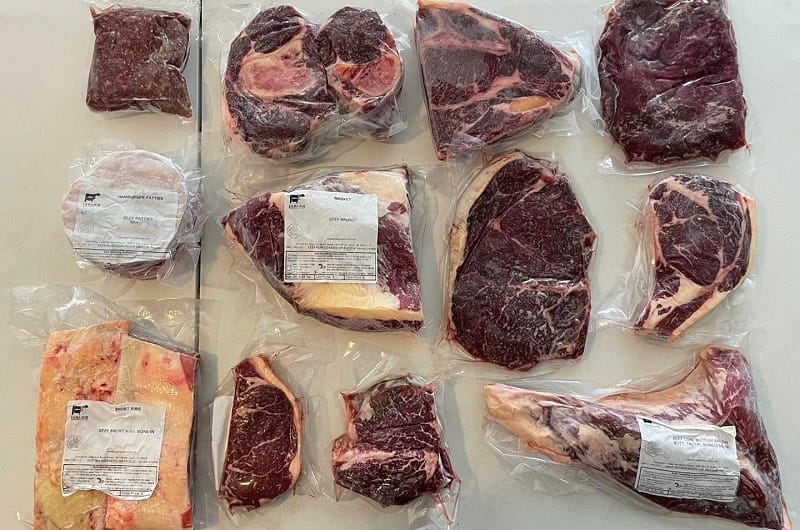
The answer is yes! When you purchase a quarter cow, you’re buying a share in the animal, which means you can talk to the butcher about how you want your meat cut.
Typically, the butcher will ask you about your preferences, including how thick you want your steaks and how you want your ground beef packaged. It’s important to remember that the specific cuts and weight you receive will depend on the rancher or supplier you’re purchasing from, but you can certainly request your preferred cuts.
Does Buying A Quarter Cow Guarantee Freshness And Quality Of The Meat?
While buying a quarter cow does not necessarily guarantee freshness and quality, it can be a great option for those who value these traits. Freshness can be extended due to the vacuum packaging used, and purchasing in bulk can result in better quality meat at a lower cost. Additionally, grass-fed cows have been found to yield meat with superior nutritional value. Ultimately, it is up to the consumer to research and choose the best option for their preferences and priorities.
Conclusion
Overall, the cost of a quarter cow can vary significantly based on the size, quality, and vendor you purchase it from. With the right knowledge and some research, you can get the best value for your money and enjoy delicious, high-quality beef.
We hope this post has been helpful in answering the question of how much is a quarter cow. If you have any other questions, feel free to leave them in the comments below.
References:
- https://thekrazycouponlady.com/tips/money/buying-cow-cost-cuts-beef-worth-it
- https://extension.sdstate.edu/how-much-meat-can-you-expect-fed-steer
- https://neighborfoodblog.com/buying-a-side-of-beef/

Hey readers! Chip Holland here, and I’m a Manager of this website. My passion for writing about it only matches my passion for BBQ. Follow my blog for mouth-watering recipes, tips, and tricks for the perfect smoke, grill, and BBQ. I’m sure you won’t be disappointed!
